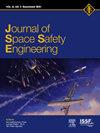调查和确定辐射剂量风险因素,这些因素来自地面风险评估,用于在不同空间天气条件下对超高空 "近太空 "飞行期间的辐照进行概率风险评估
IF 1.7
Q3 ENGINEERING, AEROSPACE
引用次数: 0
摘要
目前的太空旅游企业集中在三个具体领域:长时间非常高的高度飞行;也被称为“近太空”飞行,亚轨道飞行和低地球轨道(LEO)访问。在未来的几十年里,太空旅行有望像跨大西洋飞行一样普遍。因此,至关重要的是要考虑在这些商业活动中宇宙辐射暴露对健康的潜在影响,特别是考虑到空间天气的突然变化,如地面增强或太阳粒子事件,这可能对机组人员和乘客的健康产生深远影响。本文的重点是接触环境和相关的风险评估非常高的“近空间”飞行到平流层。目前对这类飞行危害的概率风险评估受到严重限制,因为潜在辐射暴露的必要剂量风险因素对未来的空间游客仍然不确定。在这里,我们研究了现有的陆地方法对辐射暴露的确定性和概率风险评估,特别是在民用核工业中,以及它对“近空间”非常高海拔飞行的适用性。我们提出了一种修正的概率风险评估方法,包括定制的剂量风险因子,用于“近空间”飞行。此外,我们深入研究了与“近空间”飞行相关的独特暴露事件,探讨了空间天气的潜在变化对辐射暴露的影响,并评估了潜在的剂量风险因素,以便在飞行参与者的概率风险计算中使用。摘要:一项关于乘坐新设计的飞行器在地球上层大气的非常高的高度飞行到“近空间”的潜在辐射暴露风险的可接受性和可能性的调查。比较和评估陆地核工业风险评估方法对空间旅游和相关辐射风险的适用性。本文章由计算机程序翻译,如有差异,请以英文原文为准。
Investigating and defining radiation dose risk factors, derived from terrestrial risk assessments, for probabilistic risk assessments for radiation exposure during very high altitude ‘near space’ flights for varying space weather conditions
Current space tourism ventures focus on three specific areas: long duration very high-altitude flights; also referred to as ‘near space’ flights, sub-orbital flights and visits to Low Earth Orbit (LEO). In the forthcoming decades, space travel is expected to become as commonplace as transatlantic flights. Consequently, it becomes crucial to consider the potential health implications of cosmic radiation exposure during these commercial ventures, particularly in light of sudden changes in space weather, such as ground-level enhancements (GLEs) or solar particle events (SPEs), which can have profound effects on the well-being of crew members and passengers.
This paper focuses on the exposure environment and associated risk assessment for very high altitude ‘near space’ flights to the stratosphere. The current probabilistic risk assessment of the hazards for such flights is severely constrained, as the necessary dose risk factor for potential radiation exposure remains undefined for prospective space tourists. Here we examine the existing terrestrial approach to deterministic and probabilistic risk assessment for radiation exposure, specifically within the civil nuclear industry, and its applicability to ‘near space’ very high-altitude flights.
We propose a revised probabilistic risk assessment methodology, including a bespoke dose risk factor, for ‘near space’ flights. Furthermore, we delve into the distinctive exposure events associated with ‘near space’ flights, explore the impact of potential variations in space weather on radiation exposure, and evaluate potential dose risk factors for utilization in probabilistic risk calculations for flight participants.
Plain Language Summary: An investigation into the acceptability and probability of risks associated with potential radiation exposure from flying to ‘near space’ within newly designed craft at very high altitude in the upper atmosphere above the Earth. Comparing and assessing the applicability of terrestrial nuclear industry risk assessment methodology to space tourism and the associated radiation risks.
求助全文
通过发布文献求助,成功后即可免费获取论文全文。
去求助
来源期刊

Journal of Space Safety Engineering
Engineering-Safety, Risk, Reliability and Quality
CiteScore
2.50
自引率
0.00%
发文量
80
 求助内容:
求助内容: 应助结果提醒方式:
应助结果提醒方式:


